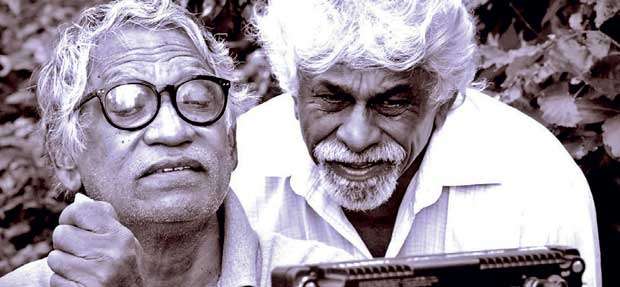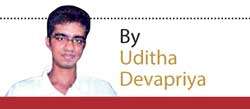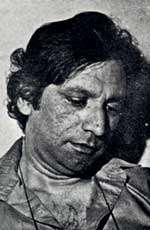Reply To:
Name - Reply Comment
Last Updated : 2024-04-25 00:00:00

Pathiraja shooting Sakkarang
 There is an extraordinary sense of mastery in Vasantha Obeyesekere’s early films. Of them, I have not watched his first, ‘Ves Gaththo’. ‘Walwath Wuwo’, ‘Diyamanthi’, and ‘Palagetiyo’ are representative of the kind of cinema he put into that work, which like ‘Walmath Wuwo’ was about the dispossessed. Buttressed by a naturalism that never even once deteriorates into melodrama, and a wide canvas that lets us both empathise and criticise his characters, these four films belong to a different world.
There is an extraordinary sense of mastery in Vasantha Obeyesekere’s early films. Of them, I have not watched his first, ‘Ves Gaththo’. ‘Walwath Wuwo’, ‘Diyamanthi’, and ‘Palagetiyo’ are representative of the kind of cinema he put into that work, which like ‘Walmath Wuwo’ was about the dispossessed. Buttressed by a naturalism that never even once deteriorates into melodrama, and a wide canvas that lets us both empathise and criticise his characters, these four films belong to a different world.
Even Diyamanthi, Obeyesekere’s most ‘mainstream’ work, displays a mastery over the medium which goes beyond just the physics of the camera. The fatal allure of youth, the exuberance of the dispossessed, the indifference of the idealist; these are the themes he visits again and again. Before Pathiraja, who would become the ultimate purveyor of the cinema of rebellion, Obeyesekere dissected the plight of the unemployed and the uprooted in ways that no other director could.
Pathiraja’s cinema offers an interesting counterpoint to Obeyesekere’s in this respect, because while both were aware of and open to the social upheaval that Sri Lanka and the young of the country experienced, they approached that theme in superficially similar, yet subtly different ways. In Pathiraja’s early work (‘Ahas Gawwa’, ‘Bambaru Awith’, ‘Para Dige’), for instance, there is some form of release, never triumphalist, but nevertheless symbolic. The protagonist’s decision to turn to a strike at the end of ‘Ahas Gawwa’, the speech by Weerasena at the end of ‘Bambaru Awith’, and the departure of Chandare and his girlfriend (“Chandare, koheda api dan yanne?” she asks twice, to which he replies, “Danne naha.”): these sequences do not vindicate the characters, nor do they absolve their weaknesses, but they provide a definite point of release for the director and the audience; almost a vindication, one could say.
Obeyesekere’s early work does not display this kind of unsettled restlessness. The heroes of ‘Walmath Wuwo’ do not turn to radicalism as easily as the protagonist of ‘Ahas Gawwa’, nor do the lovers in ‘Palagetiyo’, after a cathartic encounter over diner, resolve their differences, even in the negative way that Chandare and his girlfriend do.
Part of the reason for this may have been the influences that each imbibed. Pathiraja, in his early years, was shaped by the theatre of Beckett, which provided an at times inexplicable detour for the crises and plights that his characters face; the endings of both ‘Bambaru Awith’ and ‘Para Dige’ are intensely and insanely symbolic, and they reek of the political so much that in them, as with the plays of Beckett, we see the confluence of the real and the inexplicable.

In Pathiraja’s early work (‘Ahas Gawwa’, ‘Bambaru Awith’, ‘Para Dige’), for instance, there is some form of release, never triumphalist, but nevertheless symbolic
Theartre of cruelty
Obeyesekere, on the other hand, was shaped more by the theatre of cruelty. Though he may not have been influenced by Artaud, there are sequences in his early films which go beyond language (as with Artaud’s theatre). Many of his characters, especially the lovers in ‘Palagetiyo’, repress their destructive feelings until the very end. The ‘release’ as such that we witness at the end of these films are, therefore, not the kind what we expect. The rift between fantasy and reality, which in the director’s hands refracts the rift between the rich and the poor, is in that sense more complex than the bourgeois-proletariat tracts bordering on the Absurd we see in ‘Bambaru Awith’, and they depict the incapacity of the individual to subjugate his feelings. It is not a cinema of words and symbols; it is a cinema of thought and characters, of violence and madness.
When Sarath brings Kusum, the woman who dreams of a life of ease after eloping with him, to a shack, and slowly laughs at the fact that their new abode does not have a kitchen, a bedroom, or even a washroom, there is despair, and at the same time intense poignancy. Kusum’s efforts at getting used to this new life are not unsuccessfully (the neighbours do take kindly to her), but even with this obstacle out of the way, there is a more unyielding issue: Sarath tries futilely to find a job in the city, only to be cheated out of the little money he has by an unscrupulous dealer, and while he is out, Kusum begins to feel for another man (Ranjan Mendis, who was the antagonist in ‘Apeksha’, a more conventional take on the rich-poor/fantasy-reality rift that ‘Palagetiyo’ explored). In Obeyesekere’s early work, the social and the personal cohabit in a way that they do not in Pathiraja’s films. The one does not really displace the other, as Kusum learns to herself, at the cost of her own life, towards the end.
In an essay on ‘Bambaru Avith’, Regi Siriwardena observed that the final sequence of the film, where Weerasena makes that impassioned speech distilling the plight of the coastal peasants, was at one level unneeded. There are two ways of looking at this speech. (Wimal Kumar da Costa was probably channelling Rohana Wijeweera in his performance, since there are striking resemblances between the two.) The first, the easier way, is by considering it as a theoretical distillation, which is what it is. In this respect, it is a political expression of an actual experience. Siriwardena implies that this may have been what most audiences and critics read into the sequence. On the other hand, it can also be a critique of the attempt made by the character to distil what is otherwise a complex reality that rebels against political simplifications.
Clash between tradition and order
You can argue that the speech is a failure on the part of the revolutionary to communicate with the peasants he sympathises with, but then, the clash between the traditional order (Anton Aiya) and the new order (Baby Mahaththaya) is portrayed through a political lens to such an extent that we can’t help but view this speech itself through that same lens. It is not that the political is missing in Obeyesekere’s work from this period, but the political, no matter how intrusive it may be at certain points (in particular, in ‘Walmath Wuwo’) doesn’t intrude on the personal, at least not the extent that it does in a film like ‘Bambaru Awith’. Both Obeyesekere and Pathiraja were tempered by the political. The difference, as always then, was one of degree. In that respect, Pathiraja’s work is more intellectualised than felt, even in those sequences where the content, the experience, precedes and supersedes the form, the political. For the truth is that Pathiraja’s films are not the felt works of art they are made out to be, a contention I am willing to make at the cost of alienating a substantial readership. In fact it is less a contention than an argument, a point of view that can be borne out by a seod viewing of his early work. The uniqueness of these works is that they resist easy categorisation despite their Marxist veneer; certain sequences, like that of Weerasena’s speech, are more anti-political than political. But then, these are more the exception than the rule.
In Vasantha Obeyesekere, I noted more than a year ago, we come across a director who depicted in a fatalistic light both tradition and modernity. Pathiraja would have welcomed modernity while eschewing its capacity for exploitation. He would also have looked back to the past with anger, just as Mrinal Sen did, though unlike Sen, he did not transform from a political polemicist to “a poet committed to incertitude” (the words of James Quandt). That poet was Obeyesekere; none of his films, even the later films, depicts their milieu and their conflicts in politically clear cut terms.
When Georges Sadoul referred to the films of Lester James Peries as “models of poetry and honesty”, he was not an inexact critic making arbitrary claims. He did not mean that Peries’s works represented the societies in which they were set. In that sense, demarcating the films of Pathiraja as political does no justice in summarising the cinema he stood for. But such claims, though arbitrary, are useful when assessing the artist in comparison to, and against, the parameters of his contemporaries.
Peries’s films were models of poetry and honesty when viewed through a political lens. It was Pathiraja who made it possible for us to measure our cinema by resorting to such a lens. Viewed against it, then, Obeyesekere was less political than Pathiraja, and at the same time less personal than Peries. The latter believed, however much he denied it, in the overwhelming solace of traditionalism, while the former believed in the ravaging vicissitudes of rationality and modernity. Obeyesekere’s greatness, which came out most prominently in his early work, was that he believed in neither.
UDAKDEV1@GMAIL.COM

Add comment
Comments will be edited (grammar, spelling and slang) and authorized at the discretion of Daily Mirror online. The website also has the right not to publish selected comments.
Reply To:
Name - Reply Comment
US authorities are currently reviewing the manifest of every cargo aboard MV
On March 26, a couple arriving from Thailand was arrested with 88 live animal
According to villagers from Naula-Moragolla out of 105 families 80 can afford
Is the situation in Sri Lanka so grim that locals harbour hope that they coul